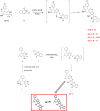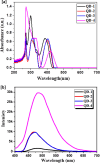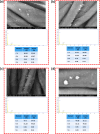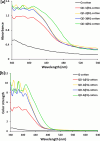Cutting edge for technical textiles (fluorescent, antibacterial and UV-protective) by incroporation of thienoisoquinoline-quinazoline derivatives
- PMID: 40537810
- PMCID: PMC12180280
- DOI: 10.1186/s13065-025-01504-3
Cutting edge for technical textiles (fluorescent, antibacterial and UV-protective) by incroporation of thienoisoquinoline-quinazoline derivatives
Abstract
Nowadays design of multi-functionalized textiles as technical textiles is highly demanded to be applied in different environments and under hard weather condition. Herein, tri-functionalized (fluorescent, antimicrobial and UV-protection) cotton textiles were designed by immobilization of heterocyclic compounds based on quinazoline derivatives (QDs). Firstly, four quinazoline derivatives (QD-1 = H, QD-2 = O-CH3, QD-3 = Cl, QD-4 = H [without COOH]) were synthesized for the first time starting from 2-(chloromethyl) quinazoline-4(3H)-one. The chemical structure of all obtained QDs were investigated by NMR (1H & 13C) and infrared spectroscopy, in addition to the measurement of melting points, yields and emission spectra. Secondly, the synthesized QDs were immobilized within cotton textile, while cotton was per-activated by interaction with cationic reagent. The modified textiles (QDs@Q-cotton) gained dark yellow color. The QDs@Q-cotton emitted greenish radiation and showed intense emission fluorescence at 485-521 nm. Good-very good (UPF = 23.6-32.8) and good (21.3-25.8) UV protection was respectively shown for QDs@Q-cotton before and after 10 washings. The protection from UV radiation for QDs@Q-cotton is attributed to the reflection of UV radiation by effect of QDs micro particles which deposited within the cotton matrix. The modified textiles exhibited antimicrobial action against S. aureus and E. coli bacteria, while the mortality was 79.9-89.1% and 69.7-76.2% before and after 10 washings, respectively. The antibacterial activity of the QDs@Q-cotton fabrics is attributed to the QDs skeleton. The highest antibacterial action for QD-3@Q-cotton is related to the chlorine derivative. The multi-functionalized textile with good durability could be successfully employed in the military/soldiers clothes.
Keywords: Cotton; Durability; Fluorescence; Quinazoline derivatives; UV-protective.
© 2025. The Author(s).
Conflict of interest statement
Declarations. Ethics approval and consent to participate: Not applicable. Consent for publication: Not applicable. Competing interests: The authors declare no competing interests.
Figures










Similar articles
-
Eucalyptus-Enhanced Cotton: Pretreatment and Bioactive Coating Strategies for the Development of Sustainable Textiles with Antimicrobial and Antioxidant Activities for Skin Applications.ACS Appl Mater Interfaces. 2025 Jun 18;17(24):35009-35022. doi: 10.1021/acsami.5c02800. Epub 2025 Jun 6. ACS Appl Mater Interfaces. 2025. PMID: 40476822
-
A rapid and systematic review of the clinical effectiveness and cost-effectiveness of paclitaxel, docetaxel, gemcitabine and vinorelbine in non-small-cell lung cancer.Health Technol Assess. 2001;5(32):1-195. doi: 10.3310/hta5320. Health Technol Assess. 2001. PMID: 12065068
-
The clinical effectiveness and cost-effectiveness of enzyme replacement therapy for Gaucher's disease: a systematic review.Health Technol Assess. 2006 Jul;10(24):iii-iv, ix-136. doi: 10.3310/hta10240. Health Technol Assess. 2006. PMID: 16796930
-
Adefovir dipivoxil and pegylated interferon alfa-2a for the treatment of chronic hepatitis B: a systematic review and economic evaluation.Health Technol Assess. 2006 Aug;10(28):iii-iv, xi-xiv, 1-183. doi: 10.3310/hta10280. Health Technol Assess. 2006. PMID: 16904047
-
Eliciting adverse effects data from participants in clinical trials.Cochrane Database Syst Rev. 2018 Jan 16;1(1):MR000039. doi: 10.1002/14651858.MR000039.pub2. Cochrane Database Syst Rev. 2018. PMID: 29372930 Free PMC article.
References
-
- Emam HE, Abdelhamid HN, Abdelhameed RM. Self-cleaned photoluminescent viscose fabric incorporated lanthanide-organic framework (Ln-MOF). Dyes Pigm. 2018;159:491–8.
-
- Emam HE, Abdelhameed RM, Ahmed HB. Multi-finished protective viscose textile via infrared assisted one-pot incorporation of Ce-organic framework. Cellulose. 2024;31:7015.
-
- Khan MZ, Ashraf M, Hussain T, Rehman A, Malik MM, Raza ZA, Nawab Y, Zia Q. In situ deposition of TiO 2 nanoparticles on polyester fabric and study of its functional properties. Fibers Polym. 2015;16(5):1092–7.
-
- Nazari A, Montazer M, Mirjalili M, Nazari S. Polyester with durable UV protection properties through using nano TiO2 and polysiloxane softener optimized by RSM. J Text Inst. 2013;104(5):511–20.
-
- Emam HE, Abdelhameed RM. Anti-UV radiation textiles designed by embracing with nano-MIL (Ti, In)–metal organic framework. ACS Appl Mater Interfaces. 2017;9(33):28034–45. - PubMed
LinkOut - more resources
Full Text Sources
